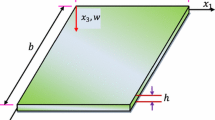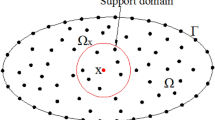Abstract
In this work, we developed a non-classical plate model for the analysis of the behavior of microplates prepared from functionally graded materials (FGMs). It was assumed that the material properties of FGM microplates vary along the direction of thickness and could be estimated using Mori–Tanaka homogenization technique. A variational approach based on Hamilton’s principle was employed to achieve motion equations and corresponding boundary conditions simultaneously. Unlike classical plate theory, the proposed plate model contained three material length scale parameters which allowed size effect to be taken into account effectively. Moreover, the proposed non-classical plate model could be divided into classical and modified couple stress plate models when all material length scale parameters were set at zero. To approve the applicability of the proposed size-dependent plate model, analytical solution for free vibration problem of a simply supported FGM microplate was obtained according to the Navier solution, where generalized displacements were stated as multiplication of undetermined functions with known trigonometric functions to identically satisfy simply supported boundary conditions for all edges. The results obtained by the proposed non-classical plate model were compared with those obtained from reduced ones relevant to different values of material property gradient index and dimensionless length scale parameter. It was found that the differences observed between the sets of predicted natural frequencies obtained from different types of plate models were more significant for lower values of dimensionless length scale parameter.



Similar content being viewed by others
References
Ansari R, Gholami R, Sahmani S (2011) Free vibration of size-dependent functionally graded microbeams based on a strain gradient theory. Compos Struct. https://doi.org/10.1016/j.compstruct.2011.06.024
Asghari M, Rahaeifard M, Kahrobaiyan MH, Ahmadian MT (2011) The modified couple stress functionally graded Timoshenko beam formulation. Mater Des 32:1435–1443
Batista M (2010) An elementary derivation of basic equations of the Reissner and Mindlin plate theories. Eng Struct 32:906–909
Chasiotis I, Knauss WG (2003) The mechanical strength of polysilicon films: part 2. Size effects associated with elliptical and circular perforations. J Mech Phys Solids 51:1551–1572
Eringen AC, Suhubi ES (1964) Nonlinear theory of simple microelastic solid-I. Int J Eng Sci 2:89–203
Eringen AC, Suhubi ES (1964) Nonlinear theory of simple microelastic solid-II. Int J Eng Sci 2:389–404
Eringen AC (1983) On differential equations of nonlocal elasticity and solutions of screw dislocation and surface waves. J Appl Phys 54:4703–4710
Fares ME, Elmarghany MK, Atta D (2009) An efficient and simple refined theory for bending and vibration of functionally graded plates. Compos Struct 91:296–305
Fleck NA, Hutchinson JW (1993) Phenomenological theory for strain gradient effects in plasticity. J Mech Phys Solids 41:1825–1857
Fleck NA, Muller GM, Ashby MF, Hutchinson JW (1994) Strain gradient plasticity—theory and experiment. Acta Metall Mater 42:475–484
Fu YQ, Du HJ, Huang WM, Zhang S, Hu M (2004) TiNi-based thin films in MEMS applications: a review. J Sensors Actuators A 112:395–408
Ganapathi M (2007) Dynamic stability characteristics of functionally graded materials shallow spherical shells. Compos Struct 79:338–343
Hasanyan DJ, Batra RC, Harutyunyan RC (2008) Pull-in instabilities in functionally graded microthermoelectromechanical systems. J Therm Stresses 31:1006–1021
Ke LL, Wang YS (2011) Size effect on dynamic stability of functionally graded microbeams based on a modified couple stress theory. Compos Struct 93:342–350
Ke LL, Wang YS, Wang ZD (2011) Thermal effect on free vibration and buckling of size-dependent microbeams. Phys E 43(7):1387–1393
Ke LL, Wang YS, Yang J, Kitipornchai S (2011) Nonlinear free vibration of size-dependent functionally graded microbeams. Int J Eng Sci 50(1):256–267
Koiter WT (1964) couple stresses in the theory of elasticity I and II. Proceedings of the Koninklijke Nederlandse Akademie van Wetenschappen 67:17–44
Kong S, Zhou S, Nie Z, Wang K (2009) Static and dynamic analysis of micro beams based on strain gradient elasticity theory. Int J Eng Sci 47:487–498
Lam DCC, Chong ACM (1999) Indentation model and strain gradient plasticity law for glassy polymers. J Mater Res 14:3784–3788
Lam DCC, Yang F, Chong ACM, Wang J, Tong P (2003) Experiments and theory in strain gradient elasticity. J Mech Phys Solids 51:1477–1508
Lee Z, Ophus C, Fischer LM, Nelson-Fitzpatrick N, Westra KL, Evoy S (2006) Metallic NEMS components fabricated from nanocomposite Al-Mo films. Nanotechnology 17:3063–3070
Liu Y, Soh C-K (2007) Shear correction for Mindlin type plate and shell elements. Int J Num Methods Eng 69:2789–2806
Ma HM, Gao XL, Reddy JN (2011) A non-classical Mindlin plate model based on a modified couple stress theory. Acta Mech 220:217–235
McFarland AW, Colton JS (2005) Role of material microstructure in plate stiffness with relevance to microcantilever sensors. J Micromech Microeng 15:1060–1067
Mindlin RD (1951) American Society of Mechanical Engineers. J Appl Mech 73
Mindlin RD, Tiersten HF (1962) Effects of couple-stresses in linear elasticity. Arch Ration Mech Anal 11:415–448
Mindlin RD (1964) Micro-structure in linear elasticity. Arch Ration Mech Anal 16:51–78
Mindlin RD (1965) Second gradient of strain and surface tension in linear elasticity. Int J Solids Struct 1:417–438
Mindlin RD, Eshel NN (1968) On first strain-gradient theories in linear elasticity. Int J Solids Struct 4:109–124
Stephen NG (1997) Mindlin plate theory: best shear coefficient and higher spectra validity. J Sound Vib 202:539–553
Timoshenko SP, Goodier JN (1970) Theory of elasticity, 3rd edn. McGraw-Hill, New York
Toupin RA (1964) Theory of elasticity with couple stresses. Arch Ration Mech Anal 17:85–112
Tsiatas GC (2009) A new Krichhoff plate model based on a modified couple stress theory. Int J Solids Struct 46:2757–2764
Vardoulakis I, Exadaktylos G, Kourkoulis SK (1998) Bending of marble with intrinsic length scales: a gradient theory with surface energy and size effects. J Phys IV 8:399–406
Wang CM, Lim GT, Reddy JN, Lee KH (2001) Relationships between bending solutions of Reissner and Mindlin plate theories. Eng Struct 23:838–849
Wang B, Zhao J, Zhou S (2010) A micro scale Timoshenko beam model based on strain gradient elasticity theory. Eur J Mech A/Solids 29:591–599
Witvrouw A, Mehta A (2005) The use of functionally graded Poly-SiGe layers for MEMS applications. Mater Sci Forum 4992–493:255–260
Xia W, Wang L, Yin L (2010) Nonlinear non-classical microscale beams: static bending, postbuckling and free vibration. Int J Eng Sci 48:2044–2053
Yang F, Chong ACM, Lam DCC et al (2002) Couple stress based strain gradient theory for elasticity. Int J Solids Struct 39:2731–2743
Fattahi AM, Sahmani S (2017) Size dependency in the axial postbuckling behavior of nanopanels made of functionally graded material considering surface elasticity. Arab J Sci Eng 1–17
Sahmani S, Fattahi AM (2017) An anisotropic calibrated nonlocal plate model for biaxial instability analysis of 3D metallic carbon nanosheets using molecular dynamics simulations. Mater Res Express 4(6):1–14
Fattahi AM, Safaei B (2017) Buckling analysis of CNT-reinforced beams with arbitrary boundary conditions. Microsyst Technol 23(10):5079–5091
Sahmani S, Fattahi AM (2017) Thermo-electro-mechanical size-dependent postbuckling response of axially loaded piezoelectric shear deformable nanoshells via nonlocal elasticity theory. Microsyst Technol 23(10):5105–5119
Fattahi AM, Sahmani S (2017) Nonlocal temperature-dependent postbuckling behavior of FG-CNT reinforced nanoshells under hydrostatic pressure combined with heat conduction. Microsyst Technol 23(10):5121–5137
Sahmani S, Fattahi AM (2016) Size-dependent nonlinear instability of shear deformable cylindrical nanopanels subjected to axial compression in thermal environments. Microsyst Technol 23(10):4717–4731
Fattahi AM, Najipour A (2017) Experimental study on mechanical properties of PE/CNT composites. J Theor Appl Mech 55(2):719–726
Azizi S, Safaei B, Fattahi AM, Tekere M (2015) Nonlinear vibrational analysis of nanobeams embedded in an elastic medium including surface stress effects. Adv Mater Sci Eng 1–7
Azizi S, Fattahi AM, Kahnamouei JT (2015) Evaluating mechanical properties of nanoplatelet reinforced composites undermechanical and thermal loads. Compu Theor Nanosci 12:4179–4185
Author information
Authors and Affiliations
Corresponding author
Rights and permissions
About this article
Cite this article
Alizadeh, M., Fattahi, A.M. Non-classical plate model for FGMs. Engineering with Computers 35, 215–228 (2019). https://doi.org/10.1007/s00366-018-0594-6
Received:
Accepted:
Published:
Issue Date:
DOI: https://doi.org/10.1007/s00366-018-0594-6




